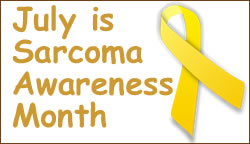Sarcoma Awareness

Malignant (cancerous) tumors of the connective tissues are called "sarcomas". There are more than 50 sub-types of sarcoma.
According to the American Cancer Society, about 11,280 people will be diagnosed with sarcoma this year and slightly more men than women develop soft tissue sarcoma. Sarcomas are cancers that are much more likely to affect children and young adults than many other more common cancers. Sarcoma is a very rare disease. Due to its rarity, it is crucial for patients to seek a cancer specialist in the treatment of their disease.
Sarcoma arises in the connective tissue of the body. The connective tissue includes muscle, bone, fat, nerve, cartilage, blood vessel, and deep skin tissue. Connective tissue is present throughout the body, so sarcoma can occur in any location. Sarcomas are divided into two main groups:
- bone sarcomas
- soft tissue sarcomas.
Two thirds of sarcomas are located in the extremities (arms or legs). Because it is so rare and it takes multiple forms in multiple locations, sarcoma is difficult to detect, often misdiagnosed and complex to treat.
Source: Sarcoma Alliance: What is Sarcoma?
Sarcoma Types
Soft Tissue Sarcomas (adult)
There are many types of soft tissue sarcoma. The cells of each type of sarcoma look different under a microscope, based on the type of soft tissue in which the cancer began.
Soft Tissue Sarcoma Subtypes
- Liposarcoma
- Fibrosarcoma
- Dermatofibrosarcoma Protuberans
- Malignant Fibrous Histiocytoma
- Synovial Cell Sarcoma
- Epithelioid Sarcomas
- Rhabdomyosarcomas
- Leiomyosarcoma
- Uterine Sarcoma
- Gastrointestinal Sarcomas(GIST)
- Myxoma, Mesenchymomas
- Vascular Sarcomas(containing many blood vessels)
- Malignant Schwannoma
- Neurosarcomas
- Alveolar Soft-Parts Sarcoma
- Kaposi's Sarcoma
Bone Sarcoma Subtypes:
- Ewing's Sarcoma
- Chondrosarcoma
- Malignant Fibrous Histiocytoma
- Osteosarcoma
Pediatric Sarcoma
Pediatric sarcomas are of three types. They are called Pediatric Sarcoma because of their greater prevalence among children compared to adults. However, they can occur in young people and adults as well.
- Rhabdomyosarcomas - tumors in the skeletal (striated) muscle and one of the most common types of soft tissue sarcoma. Rhabdomyosarcomas are often widely spread by the time a diagnosis is made. Treatment generally consists of surgery and combination chemotherapy (that is, more than one drug is used).
- Osteosarcoma - the most common type of bone cancer. Osteosarcoma usually starts in osteoblasts, which are a type of bone cell that becomes new bone tissue. Osteosarcoma is most common in teenagers. It commonly forms in the ends of the long bones of the body, which include bones of the arms and legs. In children and teenagers, it often forms in the bones near the knee.
- Ewing's Sarcoma - cancer that occurs principally in bone, most commonly affecting the long bones of the arm and leg, the pelvis, and the ribs. However, Ewing's Sarcoma can also occur in soft tissues and as such is considered a "family" of cancers that include Peripheral Neuroectodermal Tumor (PNET). It is more common in girls than boys and is rare among Africans and African-Americans. Multi-drug chemotherapy is the primary treatment in association with surgery and radiation.
Sources:
National Cancer Institute
Sarcoma Alliance:

